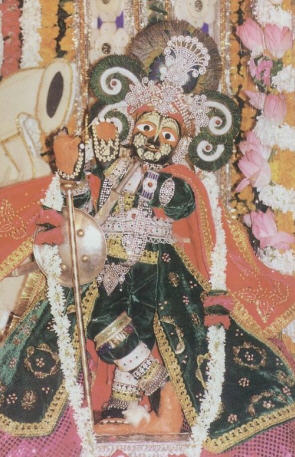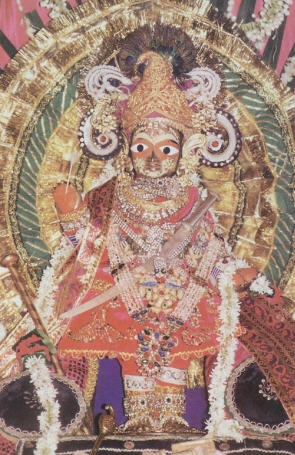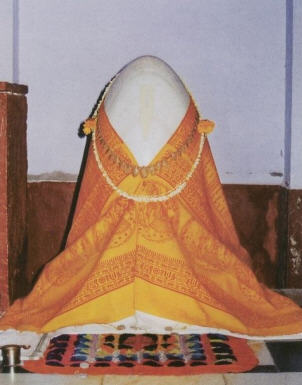The temple of Sri Radha-Madana-Mohana was the first of many Vrndavana temples built
by the followers of Sri Caitanya Mahaprabhu
"Glory to the all-merciful Radha and Madana-Mohana! I am lame and ill-advised, yet They are my directors, and Their lotus feet are everything to me." Srila Krsnadasa Kaviraja Gosvami

IN 1515 Sri Caitanya Mahaprabhu sent Rupa Gosvami and Sanatana Gosvami, two of his foremost disciples, to Vrndavana with four tasks: to write devotional books, to teach and spread the rules of devotional service, to uncover the lost places of Radha-Krsna's pastimes, and to build temples and establish deity worship. The Gosvamis accomplished all of these assignments.
The first temple to be built was that of Sri Radha-Madana-Mohana (Radha with Krsna, "the attractor [mohana] of Cupid [madana].") Like many other temples in Vrndavana, the original temple was attacked during a Mogul invasion in 1670. Part of the old temple remains today atop Dvadashaditya Hill. A new temple was built near the old one. Today two of my children and I are going to visit both temples.
Many of Vrndavana's roads are old and too narrow for a car, so we make our way by ricksha. Our driver, Vijay, comes from Mayapur, West Bengal, the birthplace of Sri Caitanya Mahaprabhu. Vijay takes on the role of guide, pointing out holy places along the route. As we pass local people, they call out "Radhe! Radhe!" and encourage my children to repeat this lovely glorification of Srimati Radharani. When my children respond, the people smile.
We arrive outside the new temple, and Vijay stops the ricksha and confirms: "Radha-Madana-Mohana."
As we enter the compound, a surge of excitement rushes through me. The temple courtyard is one of the largest in Vrndavana, and last time I came here I was with several hundred devotees holding tumultuous kirtana. Today it's just the three of us, and the temple is quiet. We make our way to the altar to see the beautiful deities, who have been decorated with intricate sandal-paste designs.
Attending the deities today is Brajesh Goswami, who is about fourteen years old. His family members, custodians of the temple, are in the disciplic line coming from Srila Sanatana Gosvami. They worship the deities according to strict rules. Brajesh asks where we are from and offers us some caranamrta (water that has bathed the deities).
Some children sitting near the altar lead us to the temple garden. In an area dotted with plants, they point to one of Sanatana Gosvami's bhajana kutirs, huts where he would sit to chant, sing, and meditate. Nearby stands a well said to have been dug by Madana-Mohana Himself with His flute. Before we leave, the children remind us to visit the old temple and point in its direction.
Madana Gopala
Madana-Mohana, Govindaji, and Gopinatha are known as the presiding deities of Vrndavana. The spiritual masters in the line of Lord Caitanya divide devotional service into three parts:  establishing our relationship with Krsna, acting in that relationship, and attaining pure love for Krsna. Madana-Mohana oversees the first division: He helps new devotees reestablish their lost relationship with Him, especially by attracting them. Krsna's name Madana-Mohana means that He's so attractive that He even attracts Cupid, who attracts everyone in this world. By worshiping Madana-Mohana we can overcome affection for Cupid (or sensual enjoyment) and become attached to Krsna.
establishing our relationship with Krsna, acting in that relationship, and attaining pure love for Krsna. Madana-Mohana oversees the first division: He helps new devotees reestablish their lost relationship with Him, especially by attracting them. Krsna's name Madana-Mohana means that He's so attractive that He even attracts Cupid, who attracts everyone in this world. By worshiping Madana-Mohana we can overcome affection for Cupid (or sensual enjoyment) and become attached to Krsna.
Five hundred years ago, the deity Madana-Mohana was known as Madana Gopala. Advaita Acarya, an intimate associate of Lord Caitanya, discovered the deity at a place near the Yamuna River now known as Advaita Vata. When Advaita Acarya returned to Bengal, he left the deity in the care of a brahmana in nearby Mathura named Purushottama Chobey. Purushottama had many children, and out of his intense love for Madana Gopala he treated the deity like one of his own children.
One day Sanatana Gosvami, while walking along the bank of the Yamuna, saw Madana Gopala in His form as a cowherd boy playing with His friends. Madana Gopala stopped playing when He saw Sanatana Gosvami, overwhelmed by the devotional activities of His great devotee.
That night Madana Gopala appeared to Sanatana in a dream.
"Because of your great love for Me," the Lord told him, "I have become attracted to you and want to come live with you in Vrndavana. I am living in the house of Purushottama Chobey in Mathura. Go there tomorrow for alms and bring Me back to Vrndavana with you."
Sanatana replied that because he was poor he didn't know how he could serve the deity nicely. But Madana Gopala assured him He would make all the arrangements for His own service.
That night Purushottama also dreamt of Madana Gopala, who told him, "You have many children, but Sanatana has none. When he comes to your home tomorrow, give Me to him."
The next day Purushottama gave the deity to Sanatana Gosvami, who made an altar out of branches and leaves next to his own thatched cottage.
The Old Temple
Vijay pedals us to the base of Dvadashaditya Hill, and we climb the steps leading to the original temple. The temple opened in 1580. Because of its historical significance, it is under the care of the Indian government. The main dome, a Vrndavana landmark, is shaped like a gigantic bottle and carved with auspicious symbols.
The temple stands where Sanatana Gosvami lived with Madana-Mohana. Constantly writing and performing other devotional practices, Sanatana was absorbed in spiritual happiness. Understanding the mind of His great devotee, Madana-Mohana would accept Sanatana's humble offerings of dry chapatis (flatbreads).
But one day Madana-Mohana asked Sanatana, "Could you at least add some salt to My chapatis?"
When Sanatana replied that he was unable to supply the salt, Madana-Mohana made His own arrangements. That day a wealthy merchant named Ramdasa Kapoor was taking a large cargo down the river to Agra when his boat got stuck on a sandbar near Dvadashaditya Hill, putting Ramdasa in great anxiety. Taking the form of a cowherd boy, Madana-Mohana went to advise Ramdasa. He informed him that on top of the nearby hill lived a great saint named Sanatana Gosvami who would certainly be able to help. Ramdasa climbed the hill and asked Sanatana what to do about the boat. Sanatana told him to pray to Madana-Mohana, as only He could help.
Ramdasa followed Sanatana's advice, and as he prayed heavy rain fell. The river soon rose, freeing the boat. Before leaving for Agra, the grateful merchant left a large chunk of salt from the cargo for Madana-Mohana.
When Ramdasa returned to Vrndavana, having made a large profit, he gave Sanatana Gosvami money to build a temple. He also gave food supplies and beautiful clothes and jewelry for Madana-Mohana.
The temple's hilltop location provides a wonderful panoramic view of Vrndavana. I look down to see the Yamuna and Kaliya Ghat, where the cargo got stuck.
Sanatana Gosvami's Samadhi

Down a grassy bank behind the temple we visit the samadhis (memorials) of Sanatana Gosvami and several other devotees, including Lord Caitanya's associates Tapana Misra and Candrasekhara Acarya. After a long life of devotional service, Sanatana Gosvami departed from the world at Govardhana Hill. His body was brought here to be entombed near his beloved deities, Radha-Madana-Mohana.
In their spiritual forms, the great saints eternally reside at their samadhis to bless those who seek their shelter. While green parrots dart around and disappear into the foliage of many trees, old sadhus sit near the samadhis, some chanting on beads, others talking quietly. They relish being in the spiritually surcharged area. I imagine that one of the sadhus might be Sanatana Gosvami himself, watching over everyone who comes here. This spot also contains a rare grantha samadhi, which contains some original scriptures written by the Gosvamis.
Sanatana Gosvami was the elder brother of Rupa Gosvami, who respected Sanatana as his guru. A verse describes their good qualities: "Within Vrndavana, Rupa and Sanatana Gosvamis were the reservoirs of natural love and mercy. They were foremost among the devotees, oceans of kindness, and friends of the poor. They possessed unflinching devotion to Radha and Krsna. Giving up all worldly pleasures, they always sang the glories of Vrndavana's groves and the lotus feet of Srimati Radharani. Therefore, these two brothers are the gifts of Sri Caitanya Mahaprabhu, the ocean of mercy. In their absence I have become an orphan." (Bhakti-ratnakara)
Sitting beside Sanatana Gosvami's samadhi, I feel honored and appreciative of what he and his associates accomplished. In the modern era, his follower Srila Prabhupada spread the message of Vrndavana to the West, and now everyone has an opportunity to visit the holy places and learn about devotional service.
Vrndavani Devi Dasi joined ISKCON in 1980. She lives with her family near Bhaktivedanta Manor in England. She would like to thank Vraja Kishor Goswami for his help in writing this article.
